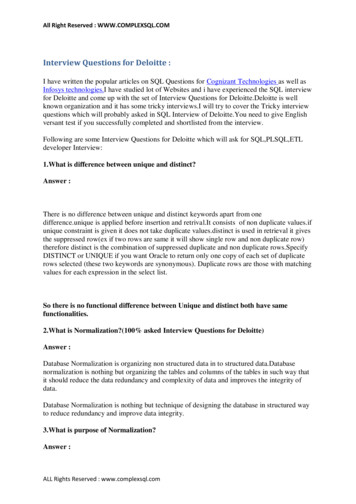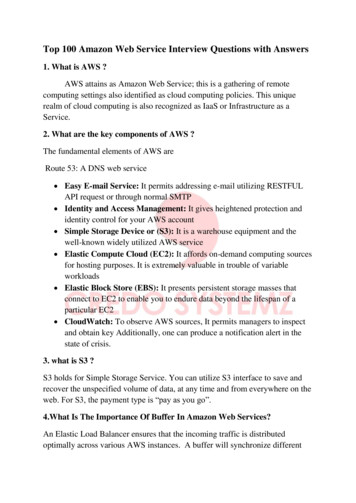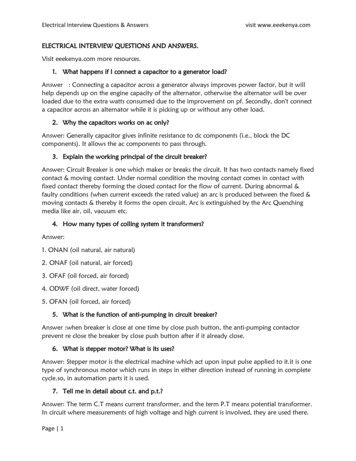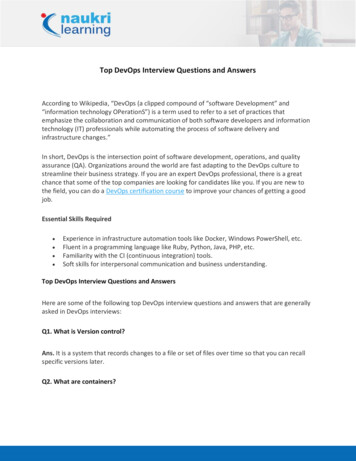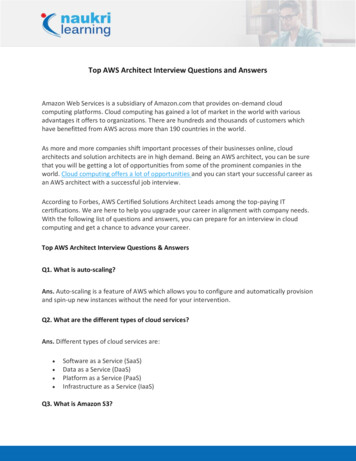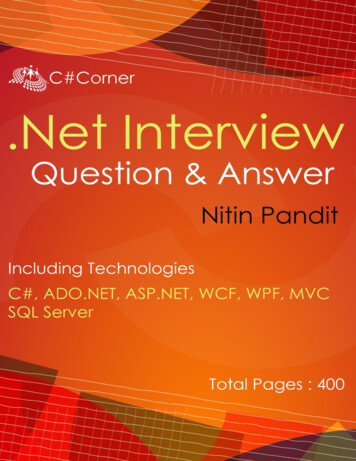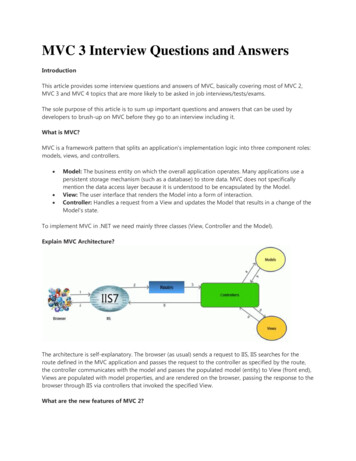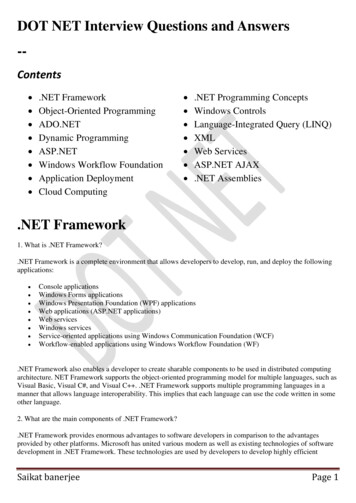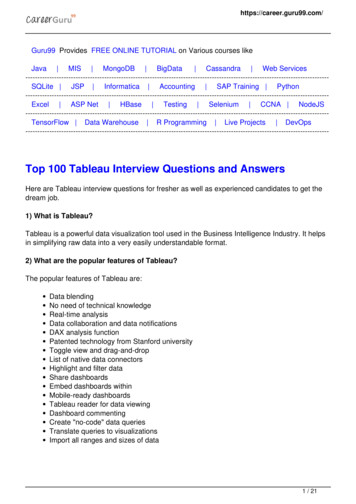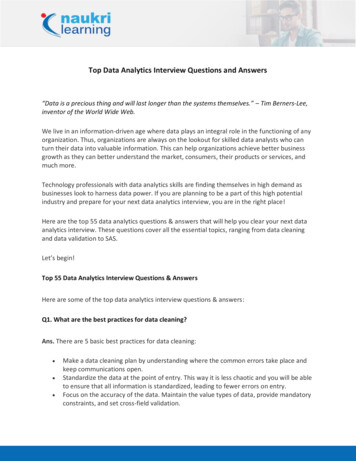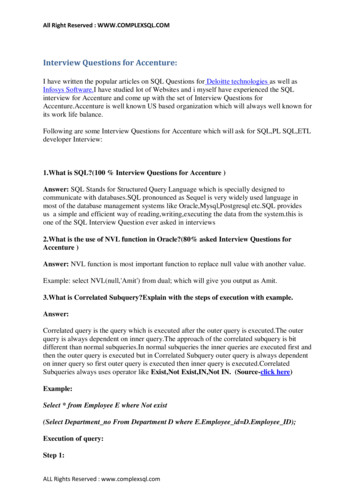
Transcription
All Right Reserved : WWW.COMPLEXSQL.COMInterview Questions for Accenture:I have written the popular articles on SQL Questions for Deloitte technologies as well asInfosys Software.I have studied lot of Websites and i myself have experienced the SQLinterview for Accenture and come up with the set of Interview Questions forAccenture.Accenture is well known US based organization which will always well known forits work life balance.Following are some Interview Questions for Accenture which will ask for SQL,PL SQL,ETLdeveloper Interview:1.What is SQL?(100 % Interview Questions for Accenture )Answer: SQL Stands for Structured Query Language which is specially designed tocommunicate with databases.SQL pronounced as Sequel is very widely used language inmost of the database management systems like Oracle,Mysql,Postgresql etc.SQL providesus a simple and efficient way of reading,writing,executing the data from the system.this isone of the SQL Interview Question ever asked in interviews2.What is the use of NVL function in Oracle?(80% asked Interview Questions forAccenture )Answer: NVL function is most important function to replace null value with another value.Example: select NVL(null,'Amit') from dual; which will give you output as Amit.3.What is Correlated Subquery?Explain with the steps of execution with example.Answer:Correlated query is the query which is executed after the outer query is executed.The outerquery is always dependent on inner query.The approach of the correlated subquery is bitdifferent than normal subqueries.In normal subqueries the inner queries are executed first andthen the outer query is executed but in Correlated Subquery outer query is always dependenton inner query so first outer query is executed then inner query is executed.CorrelatedSubqueries always uses operator like Exist,Not Exist,IN,Not IN. (Source-click here)Example:Select * from Employee E where Not exist(Select Department no From Department D where E.Employee id D.Employee ID);Execution of query:Step 1:ALL Rights Reserved : www.complexsql.com
All Right Reserved : WWW.COMPLEXSQL.COMSelect * from Employee E ;It will fetch the all employeesStep 2:The First Record of the Employee second query is executed and output is given to first query.(Select Department no From Department D where E.Employee id D.Employee ID);Step 3:Step 2 is repeated until and unless all output is been fetched. (Source-Click here)4.What is difference Between UNION and UNION All?(90 % asked in InterviewQuestions for Accenture )[caption id "attachment 225" align "aligncenter" width "300"]Union and Union all[/caption]Answer:UnionUnion ALL1.Union Set operator is used to fetch the records 1.Union all Set operator is used to fetch thefrom 2 different tables which eliminates therecords from 2 different tables which does notduplicate recordseliminates the duplicate records2.Syntax:2.Syntax:Select col1,col2 from table1;Select col1,col2 from table1;UnionUnionSelect col1,col2 from table2;Select col1,col2 from table2;3.For Performance tuning Union operator is not3.Union all is preferable operator in Performancepreferable as it takes time to eliminate duplicatetuning.recordsALL Rights Reserved : www.complexsql.com
All Right Reserved : WWW.COMPLEXSQL.COM5.What is raw datatype?Answer:Raw datatype is used to store values in binary data format.There are 2 types of RAW datatype:1.Raw2.Long Raw.Long raw datatype is used to store graphics,sound documents.Raw datatype is variable length datatype like varchar2 but basically it only stores data in 1 'sand 0's means binary data format.6.What is materialised view and what are its different fields while creating it?Answer :Materialized view is also logical structure of one or more table in which data is storedphysically in the view.Data has been stored physically in materialized view so data retrievalis faster as compare to simple view.There are following different options we used to create materialized view or snapshot.1.Build Immediate:Means materialized views(mv) created immediately.2.Build Deferred:Means materialized views(mv) created after one refresh.3.Refresh on commit:This option commited the data in materialized view in SQL immediately after data insertedand committed in table.This option is known as incremental refresh option.View is not fullyrefreshed with this option4.Refresh on Demand:Using this option you can add the condition for refreshing data in materialized views.7.Explain the difference between view and materialized view?Answer :ALL Rights Reserved : www.complexsql.com
All Right Reserved : WWW.COMPLEXSQL.COMViewMaterialized Views(Snapshots)1.View is nothing but the logical structure of thetable which will retrieve data from 1 or moretable.1.Materialized views(Snapshots) are also logicalstructure but data is physically stored indatabase.2.You need to have Create view privileges tocreate simple or complex view2.You need to have create materialized view 'sprivileges to create Materialized views3.Data retrieval is fast as compare to simple view3.Data access is not as fast as materialized views because data is accessed from directly physicallocation4.There are 2 types of views:1.Simple View2.Complex view5.In Application level views are used to restrictdata from database4.There are following types of Materializedviews:1.Refresh on Auto2.Refresh on demand5.Materialized Views are used in DataWarehousing.8.Explain different Joins in SQL?Answer:Join is nothing but connecting 2 tables to fetch the records from 2 or more differenttables.There are following types of joins in SQL:[caption id "attachment 202" align "aligncenter" width "300"]Joins in SQL[/caption]1.Inner join:Inner join retreives the records which are common between 2 or more tables.2.Outer join:ALL Rights Reserved : www.complexsql.com
All Right Reserved : WWW.COMPLEXSQL.COMOuter join retrieves the common records from the table as well as uncommon records fromLeft or right table.2.1.Left outer join:When user needs to fetch all data from left table and common records from left and righttable then the join is called as left outer join.2.2.Left outer join:When user needs to fetch all data from right table and common records from left and righttable then the join is called as right outer join.2.3.Full Outer Join:When user needs to fetch the data from both the tables and common records from both of thetables.3.Cross join/Cartesian join:When each and every record is connected to each and every record from other table then it iscalled as cross join or Cartesian join.Click Here to get information about SQL joins.9.What is mean by complete refresh in materialized view?Answer:Without a materialized view log, Oracle Database must re-execute the materialized viewquery to refresh the materialized view. This process is called a complete refresh. Usually, afast refresh takes less time than a complete refresh.A materialized view log is located in themaster database in the same schema as the master table. A master table can have only onematerialized view log defined on it. Oracle Database can use this materialized view log toperform fast refreshes for all fast-refreshable materialized views based on the master table.Tofast refresh a materialized join view, you must create a materialized view log for each of thetables referenced by the materialized view.10.What is the query to fetch number of employees departmentwise?Answer:select count(EMPNO), b.deptno, dname from emp a, dept b where a.deptno( ) b.deptnogroup by b.deptno,dname;11.What is the result of following query?select case when null null then 'Amit' else 'Rahul' end from dual;Answer:ALL Rights Reserved : www.complexsql.com
All Right Reserved : WWW.COMPLEXSQL.COMThe null null is always false.so the Answer of this query is Rahul.12.What is Index?What is use of index in SQL?Answer:Index is optional structure associated with the table which may or may not improve theperformance of Query.In simple words suppose we want to search the topic in to book we goto index page of that book and search the topic which we want.Just like that to search thevalues from the table when indexing is there you need not use the full table scan.Indexes are used to improve the performance of the query.13.What is the query to find the students who get the marks in between 30-50?Tell different ways.Answer:Select * from Student where marks between 30 and 50;Select * from Student where marks 30 and marks 50;14.What are advantages of Indexes?(90 % asked in Interview Questions for Accenture )Answer:Indexes are memory objects which are used to improve the performance of queries whichallows faster retrieval of records.Following are advantages of Indexes:1.It allows faster retrieval of data2.It avoids the Full table scan so that the performance of retrieving data from the table isfaster.3.It avoids the table access alltogether4.Indexes always speeds up the select statement.5.Indexes used to improve the Execution plan of the database15.What is parser?Answer:When SQL Statement has been written and generated then first step is parsing of that SQLStatement.Parsing is nothing but checking the syntaxes of SQL query.All the syntax of Queryis correct or not is checked by SQL Parser.ALL Rights Reserved : www.complexsql.com
All Right Reserved : WWW.COMPLEXSQL.COMThere are 2 functions of parser:1.Syntax analysis2.Semantic analysis16.What are Explicit Indexes?Answer:The indexes which is created by user are called as explicit indexes.You can say the indexeswhich are created by 'Create Index' statement are called as Explicit indexes.Syntax:create index indexname on tablename(columnname);Example:Create index IND Employee ID on Employee(Employee ID);17.What is Bit-map index?Explain with Example.(90 % asked in Interview Questionsfor Accenture )Answer:1.If Table contains the distinct values which are not more than 20 distinct values then usershould go for Bit map indexes.2.User should avoid the indexing on each and every row and do the indexing only on distinctrecords of the table column.You should able to check drastic change in query cost afterchanging the normal index to Bit map index.3.The bit map indexes are very much useful in dataware housing where there are low level ofconcurrent transactions.Bit map index stores row id as associated key value with bitmap anddid the indexing only distinct values.4.Means If in 1 million records only 20 distinct values are there so Bitmap index only stores20 values as bitmap and fetches the records from that 20 values only.Syntax:Create bitmap index Index name on Table name(Columns which have distinct values);Example:CREATE BITMAP index BM DEPT NAME on DEPT(Department name);18.What is not null constraint?ALL Rights Reserved : www.complexsql.com
All Right Reserved : WWW.COMPLEXSQL.COMAnswer:By default, a table column can hold NULL values. The NOT NULL constraint enforces acolumn to NOT accept NULL values.The NOT NULL constraint enforces a field to always contain a value. This means that youcannot insert a new record, or update a record without adding a value to this field.19.What is first and last function in SQL?Answer:The FIRST and LAST functions can be used to return the first or last value from an orderedsequence. Say we want to display the salary of each Employee, along with the lowest andhighest within their department we may use something like.Example:SELECT EmpNo, DeptNo, Sal ,MIN (Sal) KEEP (DENSE RANK FIRST ORDER BY Sal)OVER (PARTITION BY DeptNo)"Lowest", MAX (Sal) KEEP (DENSE RANK LASTORDER BY Sal) OVER (PARTITION BY DeptNo) "Highest"FROM EMPLOYEEORDER BY DeptNo, Sal;20.What is visible/invisible property of index?Answer:User can make the indexes visible and invisible by altering the indexes.Following statementis used to make indexes visible and invisible.ALTER INDEX index name VISIBLE;21.How to Find table name and its owner?Answer:To Find table name and its owner following query is used:Select table name,Owner from All tables order by table name,owner;CLICK HERE TO GET MORE INFORMATION ABOUT ORACLE SYSTEM TABLES22.What is mean by implicit index.Explain with example.Answer:Whenever we define unique key or primary key constraints on the table the index willautomatically create on the table.These indexes are known as implicit indexes because theseare created implicitly whenever the constraint has been applied to the table.These indexes areALL Rights Reserved : www.complexsql.com
All Right Reserved : WWW.COMPLEXSQL.COMnormal indexes not unique indexes.The indexes are normal because the columns already havedefined as unique so uniqueness is already been applied.Example:Create table Employee(Employee ID varchar2(20) primary key,Employee name varchar2(50),salary number(10,0) not null);If We check description of table:Desc --------------Employee IDnot nullEmployee nameSalaryvarchar2varchar2not nullnumberHere you will see index is already created for Employee ID as it has defined primary key.These are some important interview questions for accenture.Hope you like it.If you like itdont forget to share it.ALL Rights Reserved : www.complexsql.com
Following are some Interview Questions for Accenture which will ask for SQL,PL SQL,ETL developer Interview: 1.What is SQL?(100 % Interview Questions for Accenture ) Answer: SQL Stands for Structured Query Language which is specially designed to communicate with databases.SQL pronounced as Sequel is very widely used language in most of the database management systems like Oracle,Mysql,Postgresql etc.SQL
